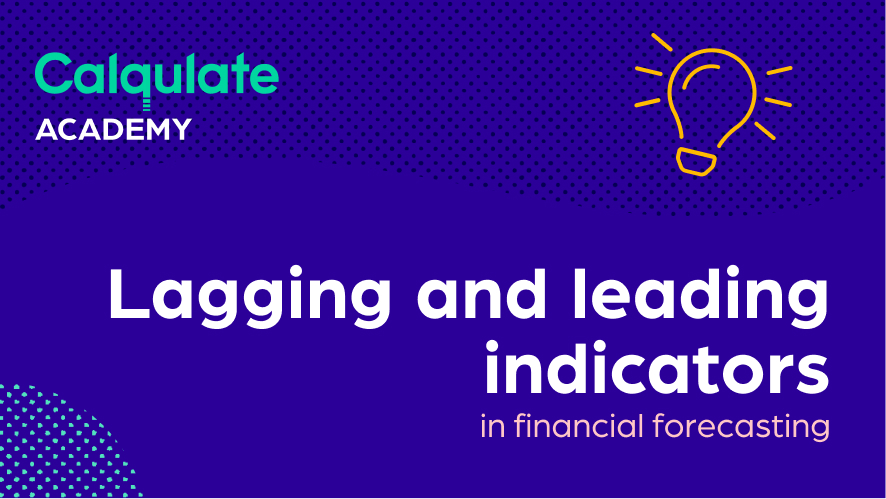If you’ve chosen the right KPIs to track your business, they can translate complex and cumbersome financial data into actionable insights. The right KPIs will also pinpoint areas that need improvement. To boost your startup finance, it's essential to understand what your indicators are telling you.
Let’s look into these more in detail and see how they can help you understand financial reporting and analytics better. We’ll start by looking at the two types of indicators – lagging and leading.
What are lagging and leading indicators?
Most business metrics can be divided between lagging and leading indicators:
-
- Lagging indicators tell you what has already happened. They look back at whether the intended result was achieved. Here are some examples of lagging indicators:
-
-
-
- Revenue
- Gross Margin %
- Churn
- EBITDA
- Number of customers
-
-
-
- Leading indicators look forward to future events, and can be used in financial forecasting. Here are some examples of leading indicators:
-
- Amount of leads in your sales funnel
- Website traffic
- Sales funnel conversion rates
- Sales headcount
- Customer satisfaction and NPS scores
- Usage frequency rate (how often are your users using your product)
-
- Leading indicators look forward to future events, and can be used in financial forecasting. Here are some examples of leading indicators:
Understanding lagging indicators
Lagging indicators always look backwards. Remember, they measure whether the intended result has been achieved. In financial reporting and performance management, they are most effective in pointing out areas of improvement and showing whether you met your targets.
For example -- Gross margin %. Let’s say you aimed to achieve a gross margin of 85% in Q2 2020 but you only managed to achieve 65%. This indicator is telling you that you are falling behind the intended result by 20 percentage points. Therefore, the actionable insight would be: You need to increase your prices or close more deals to cover your customer support costs.
However, you’ve probably seen this disclaimer several times: “Past performance does not guarantee future results and profits”.
A business leader who primarily bases strategic decisions on lagging indicators, like last year’s revenue, is driving a car by looking in the rear-view mirror. That isn’t a great way to grow one’s business.
Understanding leading indicators
Leading indicators are the day-to-day activities that lead to the result of the lagging indicators. The leading indicators drive the performance of the lagging indicators and predict future results. More sales staff and a larger marketing budget usually lead to more sales and increased revenue. Increased customer satisfaction will probably lead to lower churn and greater profitability.
How can leading indicators be linked to lagging indicators?
Always try to link leading indicators to lagging indicators. Your MRR is one of the best examples of a lagging indicator. Want to increase your MRR and sell more subscriptions? Spend more money on marketing, hire more sales staff and improve your sales funnel conversion rates.
Let’s use the same example from the previous section. Based on your lagging indicator, gross margin %, you’ve identified that you’re falling behind your gross margin % target by 20%. In order to achieve 85% gross margin, you need to:
A) Increase your prices; or
B) Close more deals to cover your customer support and other operating expenses
Say, you opted for Option B. Therefore, some of your leading indicators could be:
-
- Increase sales headcount
- Improve sales funnel conversion rates
Try to figure out which KPIs, conversion rates and resources have an impact in generating new sales and keeping your customers from churning. Then build your complete financial reporting and forecasting based on those factors. Voila! You’ve just built a financial model that connects every element. Change one factor, and everything else will be updated automatically. Predictability and scalability are the key elements in using leading indicators in financial reporting. Here’s how you can do it:
Let’s take your sales pipeline as an example. Imagine that the number of your new sales qualified leads (SQL) has stayed constant over the past year, but because your company just hired a new Lead Research Specialist and Sales Development Representative, the amount of new SQL will likely increase by 50%. You can use three leading indicators to forecast new MRR (remember revenue is a lagging indicator):
-
- Average Sales Cycle Length
-
- Understand how long it takes for a SQL to convert into a won deal
- Measure in weeks or months
-
- Average Sales Cycle Length
-
- SQL to Win ratio
-
- The number of deals won divided by the number of SQL
- Measures the quality of your leads and the efficiency of your Sales Reps
- The ratio should remain relatively predictable and stable, with the focus of improving the ratio
-
- SQL to Win ratio
-
- Average revenue per account (ARPA)
-
- The average monthly revenue of a new customer, say 150 EUR/month
- ARPA can be considered as a lagging and a leading indicator. If you look only backwards, it’s mostly a lagging indicator. If you forecast new revenue and you’re planning on doing pricing changes, the ARPA will be a leading indicator.
-
- Average revenue per account (ARPA)
This table forecasts new MRR with the help of these three leading indicators. Notice the 2-month delay in the revenue increase in November 2020.
| Jul-20 | Aug-20 | Sep-20 | Oct-20 | Nov-20 | Dec-20 | |
| # of SQL | 100 | 100 | 150 | 150 | 150 | 150 |
| SQL to Win ration % | 30% | 30% | 30% | 30% | 30% | 30% |
| # of won deals | 30 | 30 | 45 | 45 | 45 | 45 |
| ARPA / month (USD) | 150 | 150 | 150 | 150 | 150 | 150 |
| Total new MRR (USD) | 4,500 | 4,500 | 6,750 | 6,750 | 6,750 | 6,750 |
| Average sales cycle (months) | 2 | 2 | 2 | 2 | 2 | 2 |
| Revenue increase (USD) | 4,500 | 4,500 | 6,750 | 6,750 |
Key takeaway:
Your indicators will tell you a lot about your business. Identify the KPIs, conversion rates and resources that have an impact in generating new sales and keeping your customers from churning. Once you’ve done that, you can then build a comprehensive financial reporting and forecasting with actionable insights based on those factors.
Happy Calqulating!

